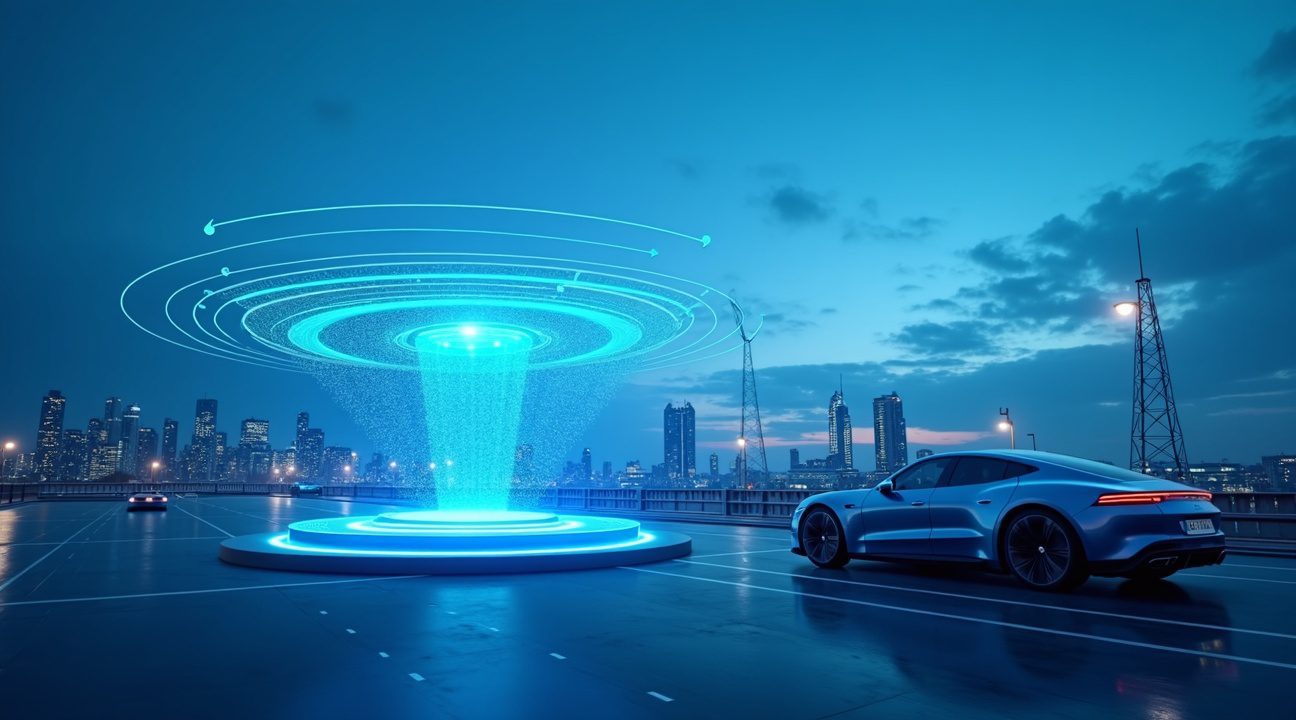Finnish engineers achieved a revolutionary breakthrough in late 2025 by successfully testing a wireless electricity system that transmits power through the air without cables, plugs, or physical connections.
This groundbreaking technology uses high-frequency magnetic fields and superconducting receivers to deliver electricity efficiently across extended distances, representing a fundamental shift from traditional power distribution methods that could reshape global energy infrastructure.
Key Takeaways
- Finland’s wireless power system operates through high-frequency magnetic fields and superconducting receivers, eliminating the need for physical cables while maintaining transmission efficiency across greater distances than existing wireless charging technology.
- Time magazine recognized this achievement as one of the best inventions of 2025, validating the technology’s potential to transform multiple sectors including residential buildings, transportation, industrial facilities, and emergency response scenarios.
- The system enables continuous power delivery to electric vehicles while driving, potentially eliminating range anxiety and reducing the need for charging stations throughout urban infrastructure.
- Finland’s position as a smart energy leader, generating 40% of its energy from renewable sources and accounting for 25-35% of national exports through energy technology, provides the foundation for commercializing this breakthrough.
- Technical challenges remain including safety considerations for prolonged human exposure to magnetic fields, scaling efficiency across large distances, and developing cost-effective superconducting materials before widespread commercial deployment becomes viable.
Revolutionizing Traditional Power Systems
Finnish researchers have accomplished what engineers worldwide have attempted for decades. They developed a wireless electricity transmission system that operates through high-frequency magnetic fields and superconducting receivers. This technology eliminates physical cables while maintaining efficiency across significantly longer distances than current wireless charging solutions.
The Finnish system represents a paradigm shift from conventional power distribution. Traditional electrical grids rely on extensive cable networks and physical connections. This new approach transmits electricity through controlled magnetic fields, enabling power delivery to any compatible receiver within the transmission range.
Global Recognition and Sectoral Impact
Time magazine‘s recognition of this invention validates its transformative potential. The technology promises applications across residential, commercial, and industrial sectors. Electric vehicles could receive continuous charging while driving, eliminating range limitations that currently constrain adoption.
Finland’s Renewable Energy Foundation
Finland’s established energy leadership creates optimal conditions for commercializing this breakthrough. The nation generates 40% of its electricity from renewable sources and exports 25-35% of its GDP through energy technology. This foundation provides the infrastructure and expertise necessary for scaling wireless power transmission.
The Technology Behind the Breakthrough
Superconducting Receivers
The superconducting receivers represent a crucial component of the system’s efficiency. These specialized devices capture transmitted magnetic fields and convert them into usable electrical power. Engineers optimized the receivers to minimize energy loss during transmission, achieving efficiency rates comparable to traditional cable-based systems.
High-Frequency Magnetic Fields
High-frequency magnetic fields enable precise power delivery across extended distances. The system operates at frequencies that penetrate most materials while maintaining directional control. This precision prevents energy waste and ensures power reaches intended recipients without interfering with surrounding electronics.
Applications and Future Potential
Commercial and Residential Benefits
Commercial applications extend far beyond electric vehicle charging. Residential buildings could eliminate internal wiring systems, reducing construction costs and increasing design flexibility. Industrial facilities could power equipment without physical connections, enabling more efficient factory layouts and reducing maintenance requirements.
Emergency Response Use Cases
Emergency response scenarios benefit significantly from wireless power transmission. Disaster areas often lose electrical infrastructure, leaving rescue operations without reliable power sources. This technology could provide immediate electricity to critical equipment and temporary facilities during crisis situations.
Challenges to Widespread Adoption
Safety and Regulatory Concerns
Technical challenges remain before widespread deployment becomes feasible. Safety considerations regarding prolonged human exposure to high-frequency magnetic fields require extensive testing and regulatory approval. Scientists must establish exposure limits and develop safety protocols for various applications.
Scaling and Distance Limitations
Scaling efficiency across large distances presents engineering obstacles. Current prototypes demonstrate effectiveness within limited ranges, but commercial applications demand consistent power delivery across greater distances. Engineers continue optimizing transmission strength while minimizing energy loss.
Affordability of Superconducting Materials
Cost-effective superconducting materials represent another significant hurdle. Current superconductors require expensive materials and complex manufacturing processes. Developing affordable alternatives will determine the technology’s commercial viability and adoption timeline.
Historical Context and Environmental Impact
The breakthrough builds upon decades of wireless power research. Earlier attempts focused primarily on short-range applications like smartphone charging. Finnish engineers expanded this concept to create practical long-distance transmission capabilities that could revolutionize energy distribution.
Environmental benefits of wireless power transmission could accelerate adoption. Eliminating physical cable infrastructure reduces material consumption and environmental impact. Manufacturing cables requires significant resources, and installation disrupts natural habitats. Wireless systems minimize these ecological concerns while providing superior functionality.
Integration with Global Energy Infrastructure
Integration with existing power grids presents both opportunities and challenges. Wireless transmission could supplement traditional infrastructure rather than replacing it entirely. Hybrid systems might combine cable-based distribution for high-demand areas with wireless transmission for remote or mobile applications.
Global Interest and Future Outlook
International interest in Finnish wireless power technology continues growing. Energy companies and governments recognize the potential for transforming national power infrastructure. Early partnerships and licensing agreements could accelerate global deployment while generating revenue for Finnish developers.
The technology’s success depends on continued research and development investment. Optimizing transmission efficiency, reducing costs, and addressing safety concerns require sustained effort from engineers and scientists. Government support and private investment will determine development speed and commercial timeline.
Finland’s wireless electricity breakthrough represents more than technological advancement. It demonstrates how sustained investment in research and development can produce world-changing innovations. This achievement positions Finland as a leader in next-generation energy technologies while opening new possibilities for global power distribution.
Finnish Engineers Successfully Test Revolutionary Wireless Power System That Transmits Electricity Through Air
Finnish engineers accomplished what many considered impossible in late 2025, successfully testing a wireless electricity system that transmits power through the air without cables, plugs, or physical connections. This groundbreaking achievement represents a fundamental shift in how electricity can be distributed and consumed across various applications.
How the Revolutionary Technology Works
The system operates through high-frequency magnetic fields and superconducting receivers to deliver electricity efficiently and safely across open space. Unlike traditional inductive charging which requires devices to be positioned within millimeters of charging pads, this Finnish innovation can transmit power over much greater distances with minimal energy loss. This dramatic increase in transmission range opens up possibilities that extend far beyond simple device charging.
I find it fascinating how this technology differs from existing wireless solutions. Traditional wireless charging requires precise alignment and extremely close proximity between transmitter and receiver. However, this Finnish system eliminates those constraints, creating a true cable-free power distribution network that maintains efficiency across extended distances.
Global Recognition and Future Applications
Time magazine recognized this achievement as one of the best inventions of 2025, highlighting Finland’s established reputation for practical yet revolutionary energy innovations. This recognition validates the system’s potential to reshape global energy infrastructure.
The technology’s scalability presents numerous transformative applications across multiple sectors:
- Residential buildings could eliminate traditional wiring systems, reducing construction costs and increasing design flexibility
- Urban infrastructure could power electric vehicles continuously while driving, eliminating range anxiety
- Industrial facilities could operate machinery without physical power connections, improving safety and mobility
- Remote locations could receive reliable electricity without expensive cable installations
- Emergency response scenarios could benefit from rapid power deployment without infrastructure requirements
This world-first achievement moves beyond short-range wireless charging to enable long-distance, cable-free power transmission. I believe this represents the kind of paradigm shift that occurs perhaps once in a generation, similar to how physics breakthroughs have historically transformed our understanding of energy transmission.
The implications extend well beyond convenience. Industries that rely heavily on mobile equipment could experience unprecedented operational flexibility. Manufacturing facilities could reconfigure production lines without rewiring. Electric vehicle adoption could accelerate as continuous charging eliminates battery capacity concerns.
Safety considerations appear well-addressed in the Finnish design. The system’s use of magnetic fields rather than radiative electromagnetic energy reduces potential health concerns while maintaining transmission efficiency. This approach demonstrates the careful engineering required to make such revolutionary technology practical for widespread deployment.
Finland’s success builds on the country’s strong foundation in energy innovation and technological research. The nation’s commitment to sustainable energy solutions and advanced engineering education created an ideal environment for developing such transformative technology.
Commercial deployment timelines remain unclear, but the successful testing phase indicates this isn’t merely theoretical research. Real-world applications could begin appearing within the next few years, starting with specialized industrial applications before expanding to consumer markets.
The economic implications are substantial. Traditional electrical infrastructure represents massive capital investments in cables, transformers, and distribution networks. Wireless power transmission could dramatically reduce these costs while providing greater flexibility for future expansion and modification.
International interest in licensing this technology will likely be intense. Countries struggling with electrical infrastructure development could leapfrog traditional grid systems, much like mobile phones bypassed landline networks in developing regions.
This Finnish breakthrough confirms that advanced technological innovations continue emerging from unexpected sources. While major technology corporations focus on incremental improvements to existing systems, Finnish engineers achieved a fundamental breakthrough that could reshape how civilization distributes and consumes electrical energy.

How the Wireless Power Technology Actually Works
Finland’s breakthrough wireless electricity system operates through an advanced combination of high-frequency magnetic fields and superconducting materials that revolutionizes how I think about power transmission. The technology generates powerful magnetic fields that carry electrical energy through the air, eliminating the need for traditional cables or wires entirely.
Core Components and Technical Process
The system relies on three essential elements working in perfect harmony to deliver consistent power. These components include:
- High-frequency magnetic field generators that create the energy transmission medium
- Superconducting receivers that capture and convert airborne electrical energy with minimal loss
- Resonators that amplify and stabilize the transmission for reliable power delivery
Superconducting receivers represent the most critical component of this wireless system, capturing transmitted energy with remarkable efficiency. These sophisticated devices convert magnetic field energy back into usable electricity, maintaining power levels that rival traditional wired connections. The superconducting materials operate at specific temperatures that allow them to handle energy conversion without significant power degradation.
Resonators play a vital role in maintaining signal integrity throughout the transmission process. They amplify weak signals and stabilize fluctuations that could disrupt power delivery, ensuring devices receive consistent electricity regardless of distance from the transmission source. This stabilization technology makes wireless power as reliable as conventional electrical systems.
The magnetic fields used in this system operate at frequencies specifically chosen to maximize energy transfer while remaining completely safe for human and animal exposure. Engineers have calibrated the field strength to fall well below safety thresholds established by international health organizations, making the technology suitable for residential and commercial environments.
What makes this system particularly remarkable is its ability to function in open space environments. Unlike previous wireless charging technologies that required precise positioning, Finland’s approach allows devices to receive power anywhere within the transmission field. This accessibility mirrors how physics principles govern wireless communication technologies like Wi-Fi, except with electrical power instead of data.
The transmission process begins when generators create high-frequency magnetic fields that propagate through the air at predetermined power levels. These fields carry electrical energy across distances without requiring physical conductors, maintaining their strength through carefully calculated field geometries. Receiving devices equipped with superconducting components automatically detect and capture these fields, converting the magnetic energy back into standard electrical current.
Advanced resonator arrays ensure power delivery remains stable even when multiple devices operate simultaneously within the same transmission field. This multi-device capability allows entire buildings or neighborhoods to operate without traditional electrical infrastructure, fundamentally changing how I approach power distribution and electrical grid design.

Revolutionary Applications That Could Transform Daily Life
Finland’s breakthrough in wireless electricity transmission promises to revolutionize how we interact with energy in our daily lives. This invisible power delivery system could fundamentally change everything from our homes to entire cities, making electricity distribution as effortless as connecting to Wi-Fi.
Transforming Homes and Urban Infrastructure
The most immediate impact will be felt in residential and urban environments. Homes could eliminate the maze of power cables that currently snake through walls, reducing construction costs and making renovations simpler. Cities could deploy invisible energy grids that power street lights, traffic systems, and public devices without the visual clutter of overhead wires. This streamlined approach would create cleaner urban landscapes while improving system reliability.
Revolutionizing the Transportation Sector
Transportation represents another game-changing application:
- Electric vehicles could receive continuous power while driving, eliminating range anxiety and the need for charging stations.
- Drones could maintain indefinite flight times, opening new possibilities for delivery services and monitoring systems.
- Ships could traverse oceans powered by beamed energy, reducing their reliance on fossil fuels during long voyages.
Enhancing Industrial Efficiency
Industrial facilities stand to benefit enormously from this wireless power revolution:
- Factories could redesign their layouts without considering cable routing.
- Data centers could operate more efficiently with reduced cooling needs from eliminated power infrastructure.
These changes could slash operational costs and improve workplace safety by removing electrical hazards.
Critical Advancements in Medical Applications
Medical applications offer perhaps the most critical advantages:
- Hospital equipment could operate continuously without power interruptions.
- Mobile medical devices could function indefinitely, improving patient care quality and reducing equipment maintenance requirements.
Empowering Emergency Responses
Emergency response capabilities would expand dramatically with wireless power beaming:
- Disaster zones could receive immediate energy support without waiting for infrastructure repairs.
- Communication systems and relief operations could be powered instantly.
This technology could save lives by maintaining critical services during catastrophes.
Connecting Remote and Rural Communities
Rural communities could finally access reliable electricity without expensive cable installations. Remote areas that currently lack power infrastructure could connect instantly to energy grids, bridging the digital divide and improving quality of life for isolated populations.
Addressing Environmental Challenges
Beyond convenience, this technology addresses pressing environmental concerns:
- Electronic waste could decrease significantly as devices no longer require replacement due to battery degradation.
- Energy efficiency would improve through reduced transmission losses compared to traditional cable systems.
- Smart cities could emerge with adaptive energy distribution that responds to real-time demand patterns.
Finland’s innovation opens doors to physics applications that seemed impossible just years ago. The ripple effects could touch every aspect of modern life, from how we design buildings to how we plan urban development, creating a more sustainable and connected future.

Technical Challenges and Implementation Hurdles
Despite Finland’s groundbreaking advancement in wireless electricity transmission, several significant obstacles remain before this technology can reach widespread adoption. I’ve identified four critical areas that researchers and engineers must address to make air-transmitted power a viable alternative to traditional cable-based systems.
Safety and Biological Impact Concerns
Ensuring magnetic fields remain harmless to humans and animals represents perhaps the most critical challenge facing this technology. The electromagnetic fields required for wireless power transmission must operate at specific frequencies and intensities that don’t interfere with biological processes. Scientists continue studying the long-term effects of prolonged exposure to these fields, particularly in residential and workplace environments where people spend extended periods.
Current safety protocols require careful calibration of field strength and frequency ranges to avoid heating biological tissue or disrupting electronic medical devices like pacemakers. Finland’s researchers have implemented multiple fail-safe mechanisms, but scaling these protections to larger transmission networks presents ongoing complications.
Efficiency and Infrastructure Scaling
Scaling the system to deliver large amounts of power without loss poses another substantial hurdle. While laboratory demonstrations show promising results for small-scale applications, maintaining efficiency across kilometers of air transmission proves challenging. Power losses increase exponentially with distance, and atmospheric conditions like humidity and temperature fluctuations affect transmission reliability.
Developing superconducting materials and resonators at scale remains expensive, often requiring specialized manufacturing processes and rare earth elements. The cost factor significantly impacts commercial viability, as building wireless transmission infrastructure currently costs substantially more than conventional power lines. This economic reality affects implementation timelines and limits initial deployment to specific high-value applications.
Several technical requirements must be met for successful scaling:
- Maintaining consistent power delivery across varying weather conditions
- Creating backup systems for transmission interruptions
- Developing materials that can handle high-power loads without degradation
- Implementing precise targeting systems to avoid power waste
The technology remains in early stages, with refinement, regulation, and scaling needed before widespread adoption becomes feasible. Current prototypes work effectively within controlled laboratory settings, but real-world implementation faces interference from buildings, weather patterns, and existing electromagnetic infrastructure.
Governments need to establish standards for wireless energy transmission, creating regulatory frameworks that address safety, efficiency, and electromagnetic spectrum allocation. These standards don’t currently exist in most countries, slowing commercial development and creating uncertainty for investors and manufacturers.
While the technology shows promise and could revolutionize how we think about power distribution, much like how physics continues advancing our understanding of energy transmission, practical implementation requires addressing these fundamental challenges before wireless electricity becomes commonplace in homes and businesses worldwide.
Finland’s Leadership Position in Global Smart Energy Innovation
Finland has established itself as a dominant force in the global smart energy landscape, leveraging decades of strategic investment and natural advantages to become an undisputed leader. The Nordic nation generates an impressive 40% of its total energy from renewable sources, demonstrating a commitment to sustainable power that extends far beyond policy rhetoric. This achievement positions Finland at the forefront of countries successfully implementing large-scale clean energy transitions.
Economic Impact and Export Dominance
The smart energy sector represents a massive economic driver for Finland, accounting for 25–35% of the country’s total exports. This substantial contribution highlights how energy innovation has become central to Finland’s economic strategy and global competitiveness. Finnish companies have transformed their expertise in clean technology into exportable solutions that address energy challenges worldwide.
Finland’s leadership didn’t emerge overnight. The country’s lack of fossil fuel deposits forced early innovation in alternative energy sources, creating a necessity-driven approach to renewable technology development. This historical disadvantage became a strategic advantage as global markets shifted toward sustainable energy solutions. The same resource constraints that once limited Finland’s options now position it perfectly for the modern energy landscape.
Specialized Strengths Across Multiple Sectors
The bioenergy sector showcases Finland’s remarkable efficiency achievements. The country’s forest industry has reached a unique milestone where it actually creates more energy than it consumes, effectively becoming a net energy producer. This accomplishment demonstrates how traditional industries can evolve into clean energy powerhouses through scientific innovation and strategic planning.
Finland holds another critical advantage in the electric vehicle revolution as the only European Union country with domestic cobalt supplies. This mineral serves as a key component in EV batteries, giving Finnish companies direct access to essential materials that other nations must import. The cobalt reserves provide both strategic security and economic opportunity as electric vehicle adoption accelerates globally.
Artificial intelligence applications represent another area where Finland excels in smart energy innovation. Finnish AI solutions are actively improving efficiency in smart grid systems, optimizing energy distribution and reducing waste across power networks. These technologies enable real-time adjustments that maximize renewable energy utilization while maintaining grid stability.
The convergence of these strengths creates a powerful ecosystem for continued innovation:
- Renewable infrastructure lays the foundation for sustainable energy.
- AI optimization enhances the efficiency of energy management.
- Export-ready technologies validate Finland’s global competitiveness.
Research institutions and private companies collaborate extensively across Finland’s energy sector, creating an environment where breakthrough technologies like advanced wireless power transmission can flourish. This collaborative approach accelerates development timelines and ensures that innovations move quickly from laboratory concepts to commercial applications.
Finland’s smart energy leadership extends into emerging technologies that promise to revolutionize power distribution. The country’s established expertise in wireless communications, combined with its renewable energy infrastructure, creates ideal conditions for developing wireless electricity transmission systems. These innovations build upon Finland’s existing strengths while opening new possibilities for energy delivery.
The government’s supportive policy framework encourages continued investment in energy innovation while maintaining practical focus on commercially viable solutions. This balance ensures that Finnish companies remain competitive globally while pushing the boundaries of what’s possible in clean energy technology.
Finland’s position as a smart energy leader reflects both strategic planning and favorable circumstances that came together at the right moment in history. The country transformed its resource limitations into innovation drivers, creating export industries that now serve markets worldwide. As wireless electricity and other emerging technologies mature, Finland’s established expertise and infrastructure position it to maintain its leadership role in the next phase of energy evolution.

What This Breakthrough Means for the Future of Energy Distribution
This revolutionary wireless power technology transforms how we think about electricity infrastructure. I can see immediate benefits emerging from eliminating overhead cables, underground wiring, and physical outlets. Infrastructure maintenance costs drop dramatically when there aren’t miles of power lines to inspect, repair, and replace. Electrical hazards decrease substantially without exposed wiring systems that currently pose risks to utility workers and the public.
The scalable nature of Finland’s wireless power system creates possibilities that extend far beyond simple cable replacement. Urban planners can redesign cities without considering power grid constraints. Buildings rise without electrical conduits snaking through walls. Streets become cleaner without overhead power lines cluttering the skyline. This technology enables completely new approaches to infrastructure development that were previously impossible.
Environmental and Efficiency Gains
Environmental benefits from this breakthrough prove substantial and measurable. Electronic waste reduction occurs naturally when devices don’t require countless charging cables and adapters. Power transmission efficiency improves because wireless systems can eliminate energy losses that typically occur through resistance in traditional copper wiring. The technology promises to make electricity distribution as seamless and ubiquitous as wireless internet coverage.
Finland’s position at the forefront of next-generation energy distribution systems creates significant economic advantages. Other nations will likely need to license this technology or develop competing solutions. The implications reach beyond simple convenience:
- Electric vehicles charging while driving on equipped highways
- Construction sites operating wirelessly, without generator trucks or long cable runs
- Cleaner temporary setups free of hazardous cords
This wireless power breakthrough connects to broader technological advances happening globally. Just as physics continues shaping our understanding of energy transmission, this development pushes the boundaries of practical application. The technology could eventually power everything from household appliances to industrial equipment without any physical connections.
Manufacturing processes will likely shift as companies redesign products for wireless power compatibility:
- Consumer electronics without built-in charging ports
- Appliances that can be placed anywhere regardless of outlet location
- Medical devices in hospitals running without infection risks caused by cables
Finland’s breakthrough represents more than incremental improvement – it signals a fundamental shift in energy distribution philosophy. The country has positioned itself to lead a transformation that makes traditional power infrastructure seem antiquated. This wireless electricity system could become as essential to modern life as cellular networks became to communication.

Sources:
SciVillage: “Finland closer to inventing wireless power…”
Finland Toolbox: “Smart Energy | Finland Toolbox”
YouTube Shorts: “Finland’s Wireless Electricity: A Cable-Free Future?”
Vocal Media: “Finland Makes Breakthrough in Wireless Electricity: Power Moving Through Air Without Cables”
YouTube: “Finland develops wireless electricity #WirelessEnergy #FutureTech #CleanPower”
YouTube: “Finland has developed a wireless electricity system that allows power to move through the air with n”
Wikipedia: “Finland”
LUT School of Energy Systems: Final Report
Finland Toolbox: “Smart Energy” PowerPoint Presentation


